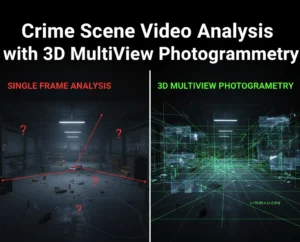Crime Scene Video Analysis with 3D MultiView Photogrammetry
When it comes to solving crimes, the smallest details can make the biggest difference. A single measurement, an overlooked angle, or even a missed perspective can completely change how investigators understand what happened at a scene. That’s why crime scene video analysis has become such a powerful tool for law enforcement and forensic experts. But not all methods of analysis are created equal.
For years, many analysts relied on Single Frame Metrology—a method that pulls measurements from just one video frame or image. While it has its uses, the reality is that single-frame information can only take you so far. Crime scenes are complex, three-dimensional environments. Limiting analysis to a single snapshot often means you’re leaving critical data behind. That’s where 3D MultiView Photogrammetry changes the game.
Why Camera Calibration Matters
Imagine you’re analyzing video from a crime scene. With Single Frame Metrology, you’re essentially freezing the scene into one image and then trying to extract measurements. Sure, you can calculate some distances, but the process is limited and requires a lot of manual work. Every reference point in the XYZ space has to be measured individually, which is not only time-consuming but also prone to human error.
Even worse, because you’re only working from one angle, accuracy is limited. Real crime scenes rarely present themselves in neat, flat surfaces. There are depth changes, multiple objects, and subtle details that can’t be fully captured from just one perspective. That’s why single-frame methods often miss the bigger picture.
3D MultiView Photogrammetry
Now, let’s flip the script. 3D MultiView Photogrammetry doesn’t restrict investigators to one frozen frame. Instead, it takes multiple images or frames from different angles and reconstructs the scene in three dimensions.
Here’s why that’s so important:
- Higher Accuracy: MultiView measurements don’t require manually plotting out every XYZ point. With just a single scale measurement, the system can handle the rest, often delivering equal or better accuracy compared to single-frame techniques.
- More Data, Less Error: By using multiple images, you reduce reliance on one perspective. That means small details like the relative height of an object or the exact position of evidence are far less likely to be misinterpreted.
- Efficiency in the Field: Instead of spending hours on manual calculations, MultiView Photogrammetry streamlines the process, allowing investigators to focus on interpreting results rather than crunching numbers.

What This Means for Crime Scene Video Analysis
For forensic experts, accuracy isn’t optional—it’s everything. Court cases, legal outcomes, and even justice itself depend on getting the measurements right. With 3D MultiView Photogrammetry, crime scene video analysis can move beyond basic approximations and deliver results that stand up under scrutiny.
Think about reconstructing a shooting scene. Single frame methods might give you a rough idea of distances, but MultiView can map the entire environment, from bullet trajectories to suspect positions, with greater precision. Or consider a hit-and-run investigation. Multiple video frames from security cameras can be pieced together to calculate exact vehicle speeds and positions—something nearly impossible with just a single image.
Beyond the Basics: Why Photogrammetry Matters
Photogrammetry isn’t new – it’s been around for decades in fields like surveying, mapping, and even archaeology. But applying it to forensic video analysis takes it to a new level. In criminal investigations, where evidence has to hold up in court, the ability to generate accurate, repeatable, and scientifically validated measurements is priceless.
MultiView Photogrammetry also brings scalability. Whether the evidence comes from a body cam, a dash cam, or a CCTV system, the method adapts to different video sources. That flexibility gives investigators a consistent and reliable way to measure crime scenes across a wide range of cases.
Why This Sets Cognitech Apart
Many companies still rely heavily on Single Frame Metrology, but the limitations are clear. Cognitech’s approach with 3D MultiView Photogrammetry sets a higher standard. Instead of forcing investigators to work harder for less data, our software empowers them with richer, more accurate reconstructions. The result? Evidence that doesn’t just look convincing but is scientifically airtight.
And in a world where video evidence is often the deciding factor in court, that accuracy can mean the difference between justice served and justice denied.
The Future of Forensic Video Analysis
Crime scenes will always be complex. But with advanced tools like 3D MultiView Photogrammetry, forensic video analysis is evolving to meet that complexity head-on. By moving beyond single-frame limitations, investigators gain a clearer, more accurate picture of events, one that stands up in both the lab and the courtroom.
As technology continues to advance, one thing is certain: the future of forensic science isn’t flat. It’s three-dimensional.
Talk with experts for Forensic video Processing Software and Forensic Image Processing Software solutions. Contact Cognitech! We hope you enjoyed this Blog! Stay tuned, and don’t miss the coming blogs. You can follow us on Twitter, Facebook, Instagram, Linkedln, or Youtube: we post Community Blogs regularly, so you won’t miss any!
FAQs
Q1: What is crime scene video analysis?
Crime scene video analysis is the process of extracting and interpreting evidence from video footage to reconstruct events and gather accurate measurements for investigations.
Q2: Why is Single Frame Metrology limited for forensic work?
Single Frame Metrology relies on one image, which restricts accuracy and requires manual XYZ measurements. This often misses critical details in complex crime scenes.
Q3: How does 3D MultiView Photogrammetry improve accuracy?
By combining multiple images, 3D MultiView Photogrammetry reconstructs a crime scene in three dimensions, delivering precise measurements with fewer errors.
Q4: Can MultiView Photogrammetry be used with CCTV or body cam footage?
Yes. MultiView Photogrammetry adapts to different video sources like CCTV, dash cams, and body cameras, making it versatile for real-world investigations.
